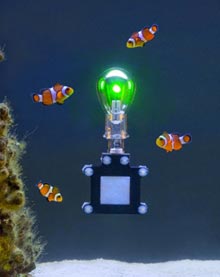Waterproof Lithium-Air Batteries
A company based in Berkeley, CA, is developing lightweight, high-energy batteries that can use the surrounding air as a cathode. PolyPlus is partnering with a manufacturing firm to develop single-use lithium metal-air batteries for the government, and it expects these batteries to be on the market within a few years. The company also has rechargeable lithium metal-air batteries in the early stages of development that could eventually power electric vehicles that can go for longer in between charges.

Interest in lithium metal-air batteries has been growing in recent years, along with the demand for lighter power sources for devices ranging from plug-in hybrid vehicles to laptops. In lithium-ion batteries, the electrodes are made of materials such as graphite, while in a lithium-metal battery, the anode is made up entirely of lithium metal, and the surrounding air can act as the cathode.
Lithium-metal batteries approach the energy density of fuel cells without the plumbing needed for these devices; in theory, the maximum energy density is more than 5,000 watt-hours per kilogram, or more than 10 times that of today’s lithium-ion batteries. Lithium metal-air batteries are also very lightweight because it’s not necessary to carry a second reactant. Lithium metal is “the holy-grail battery material,” says Steven Visco, chief technical officer and founder of PolyPlus.
IBM recently announced that it would develop lithium metal-air batteries for the energy grid and for transportation. “Lithium ion is the gold standard, but what can beat it is lithium metal,” says Paul Beach, president of battery manufacturer Quallion of Sylmar, CA.
Using lithium metal as a battery electrode, however, has proved problematic, mainly because the material reacts rapidly and violently with water. “People have thought about lithium-air batteries for decades, but there’s always water in the air,” says Visco. Exposure to even traces of water rapidly degrades the material.
PolyPlus has solved this problem by developing what the company calls a “protected lithium electrode.” The device consists of a flat, rectangular piece of lithium metal overlaid on either side with a ceramic electrolyte material called lisicon. The solid electrolyte is impermeable to water but lets lithium ions pass through. Another coating protects the electrolyte from reacting with the lithium metal. And finally, the edges of the device are sealed with an aluminum-polymer laminate similar to a potato-chip bag. The laminate provides a watertight seal, and it’s flexible, so it doesn’t create any strain when the electrode shrinks with use.
When the lithium-metal electrode is placed in water, lithium ions leak out and react with oxygen dissolved in the water or with the water itself. To make a lithium metal-air battery, the device is fitted with a gas-diffusion electrode similar to those used for zinc metal-air hearing-aid batteries. When the battery is switched on, the electrode draws in oxygen through the membrane to react with the lithium ions. But unlike hearing-aid batteries, these devices won’t self-discharge over time. “You can leave the battery on the shelf for months and expect it to work because the membrane protects it,” says Visco. And because they’re based on high-energy lithium metal, these batteries last much longer and are more lighter than zinc-air batteries.
PolyPlus is currently testing lithium metal-seawater batteries in conjunction with the Monterey Bay Aquarium Research Institute to determine whether they can withstand real working conditions. One concern is that microorganisms in the ocean will grow on the batteries’ surface and impair their operation, although preliminary tests have produced good results.
The single-use batteries made by the company employ a piece of lithium metal about two centimeters squared and three millimeters thick; they have a storage capacity close to that of the lithium-ion batteries in today’s laptops at one-fifth the weight. The company has partnered with battery manufacturer Quallion to produce batteries based on PolyPlus’s electrode designs and will make batteries under contract for an undisclosed government agency. Quallion says that lithium-metal electrodes can be processed using much of the infrastructure already in place for making lithium-ion batteries. “Certain precautions are needed to handle the material, but there are no tricks to it,” says Beach.
Lithium-metal batteries have the potential to be “transformational” for underwater applications, says James Bellingham, the Monterey Bay Aquarium Research Institute’s chief technologist. Most ocean research takes place close to shore because, as Bellingham says, “in the ocean, there are no plugs” for recharging the sensor-laden autonomous craft that monitor the seas. Higher energy-density batteries could enable much better monitoring of the effects of climate change on the planet, says Bellingham.
Keep Reading
Most Popular
Large language models can do jaw-dropping things. But nobody knows exactly why.
And that's a problem. Figuring it out is one of the biggest scientific puzzles of our time and a crucial step towards controlling more powerful future models.
How scientists traced a mysterious covid case back to six toilets
When wastewater surveillance turns into a hunt for a single infected individual, the ethics get tricky.
The problem with plug-in hybrids? Their drivers.
Plug-in hybrids are often sold as a transition to EVs, but new data from Europe shows we’re still underestimating the emissions they produce.
Stay connected
Get the latest updates from
MIT Technology Review
Discover special offers, top stories, upcoming events, and more.